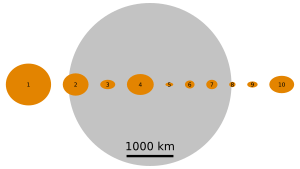9 Metis facts for kids
- For the moon of Jupiter, see Metis (moon).
| Discovery | |
|---|---|
| Discovered by | A. Graham |
| Discovery date | April 25, 1848 |
| Designations | |
| 1974 QU2 | |
| Main belt | |
| Orbital characteristics | |
| Epoch July 14, 2004 (JD 2453200.5) | |
| Aphelion | 400.548 Gm (2.678 AU) |
| Perihelion | 313.556 Gm (2.096 AU) |
| 357.052 Gm (2.387 AU) | |
| Eccentricity | 0.122 |
| 1346.815 d (3.69 a) | |
|
Average orbital speed
|
19.21 km/s |
| 274.183° | |
| Inclination | 5.576° |
| 68.982° | |
| 5.489° | |
| Physical characteristics | |
| Dimensions | 235×195×140 km |
| Mass | ~9×1018 kg |
|
Mean density
|
~2.7 g/cm³ |
| ~0.070 m/s² | |
| ~0.11 km/s | |
| 0.2116 d (5.078 h) | |
| Albedo | 0.243 (geometric) |
| Temperature | ~173 K max: 282 K (+9° C) |
|
Spectral type
|
S-type |
| 8.1 to 11.83 | |
| 6.28 | |
| 0.23" to 0.071" | |
9 Metis is one of the largest asteroids in the main asteroid belt. It is mostly made of silicate rocks and metals like nickel and iron. Scientists think it might be the leftover core of a much bigger asteroid. This larger asteroid was likely destroyed long ago in a huge space crash.
Discovery and Naming

The asteroid Metis was discovered by Andrew Graham. He found it on April 25, 1848. This was the only asteroid he ever discovered. It is also the only asteroid found from observations made in Ireland.
Metis is named after a figure from ancient Greek myths. Metis was a Titaness (a powerful goddess from an older generation of gods) and an Oceanid (a sea nymph). She was the daughter of Tethys and Oceanus. The name Thetis was also thought of for the asteroid but was not chosen. Another asteroid, 17 Thetis, later received that name.
What Metis is Like
We don't know which way Metis is spinning right now.
Pictures from the Hubble Space Telescope and studies of how its brightness changes show that Metis is not perfectly round. It has a stretched shape, with one end being pointy and the other wider. Radar observations also suggest it has a flat area. This matches the shape scientists have figured out from its light changes.
Scientists believe the surface of Metis is made of about 30-40% metal-rich olivine (a common green mineral) and 60-70% nickel-iron metal.
At one point, data about Metis's light suggested it might have its own moon. However, later observations did not confirm this idea. Searches using the Hubble Space Telescope in 1993 also did not find any moons around Metis.
Star Blockages
Metis has passed in front of, or "occulted," stars at least five times. When an asteroid occults a star, it means the asteroid temporarily blocks the star's light from reaching Earth. This helps scientists learn more about the asteroid's size and shape.
Images for kids
-
A 3D model of Metis based on how its brightness changes.
See also
 In Spanish: (9) Metis para niños
In Spanish: (9) Metis para niños

